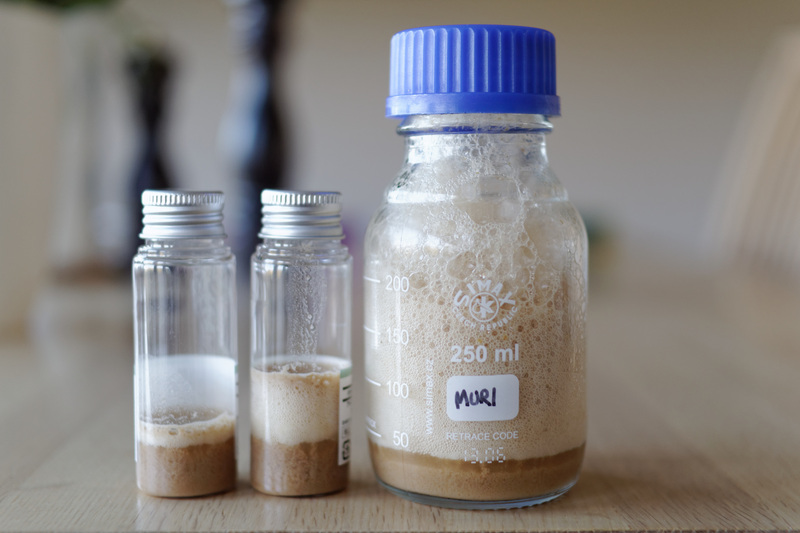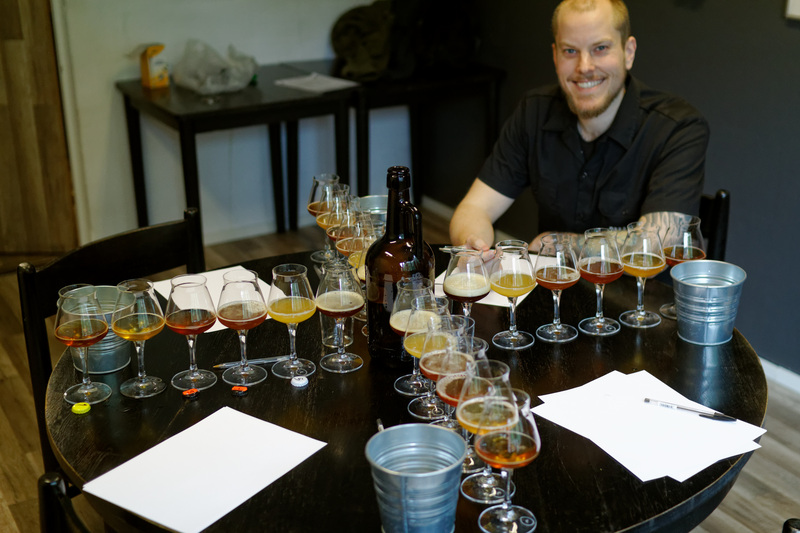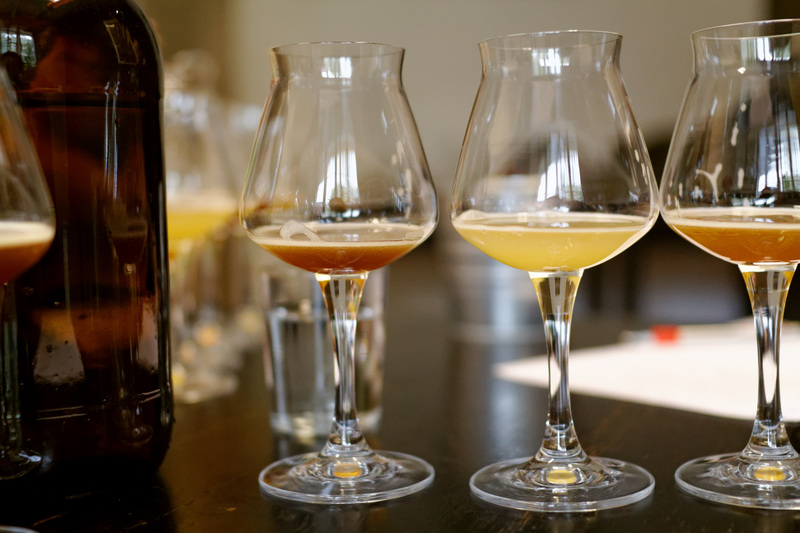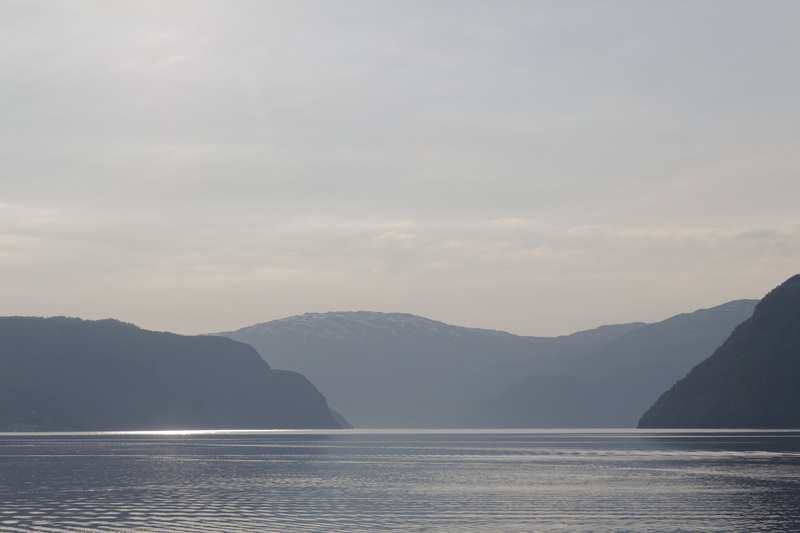The Muri mystery

The Muri yeast as I first received it, via MicroMaid. |
Back in 2014, when people first started getting seriously interested in kveik, a homebrewer named Bjarne Muri realized he might be able to contribute something. He came from the farm Muri in Olden in Nordfjord, western Norway, not far from Hornindal. His grandfather was a farmhouse brewer, and the last time they brewed on the farm was in 1991. Two things remained from that final brew: a home-made video, and the yeast, dried and stored in an outhouse on the farm.
The talk about kveik made Bjarne remember this old, stored yeast, and he decided to try to revive it. His friend, whom he usually home brews with, told me that they went through many attempts to get the yeast to grow, and mostly they got "black stuff," which wouldn't grow. But eventually they succeeded, and had a yeast that could ferment beer at high temperatures. They quite reasonably concluded they had revived the family kveik, and started sharing it around.
Bjarne Muri even walked into a local homebrew shop and gave them the yeast. The shop sent it on to White Labs, and White Labs made it available commercially as WLP 6788 Muri. 6788 is the postal code of Olden, where the Muri farm is. (In the registry, this yeast is listed as #4 Muri.)

Ready to judge the homebrews with Amund Polden Arnesen |
Thanks to the "sponsorship" from White Labs there was a good bit of excitement around this yeast quite early. My friends Amund and Bjørn even arranged a home-brewing contest dedicated to this yeast, where I was one of the judges. And it immediately struck me that something about this yeast was strange.
Apart from the high temperature, kveik is famous for being a non-phenolic farmhouse yeast that produces drinkable beer very quickly. And yet the beers I tasted at that contest were all phenolic. And a lot of them had a quite powerful aroma of rubber. In some cases I described it as similar to the aroma of newly purchased rubber boots. But some beers had a quite nice fruity aroma. After the contest I gathered brewing data from as many of the participants as I could, and came to the conclusion that the rubber aroma faded after some months of maturation. Not very like kveik.
Today, the situation is that some 30-odd cultures of yeast have been collected from western Norway, and every single one except Muri is kveik. Of course, we don't know that absolutely every farmhouse brewer in western Norway used kveik. (Remember that every farmer in western Norway was also a brewer. Literally every single one.) But the local custom was to have oppskåke just a few days after brewing, and at the oppskåke all your neighbours would be not only drinking the beer, but also judging it. And they had brewed beer all their lives, so these were pretty well informed judges.
How could beer fermented for a couple of days with Muri have passed muster with the locals? That just didn't seem plausible to me. So I concluded that the original yeast must have died, and Bjarne Muri must have (without knowing it) grown some wild yeast from the air in his apartment.

Beers fermented with Muri |
Seems reasonable, right? Except it's not that simple.
The yeast was also sent out to various labs, and Richard Preiss sent it on to Kristoffer Krogerus, who did whole-genome sequencing on it. The results were quite startling. Surprising enough, actually, that Krogerus published a separate paper on just this yeast.
So what did he find?
Well, kveik, as we all know, is Saccharomyces cerevisiae, just like all other ale yeast, and most bread yeast, wine yeast, sake yeast, and even many wild yeasts. Muri, on the other hand, turns out to be a hybrid of Saccharomyces cerevisiae and Saccharomyces uvarum. That's surprising in itself, but the two parents seem to be closest to English ale yeast and central European cider and wine yeast. (English ale yeast might sound close to kveik, but this is Beer 2, not Beer 1.)
If this yeast was not the ancestral Muri farm yeast, what was it doing in Bjarne Muri's apartment? It very clearly is not a wild yeast, but a mix of two domesticated yeasts. It doesn't seem very plausible that the air in Oslo is full of those. On the other hand it doesn't seem at all plausible that this was the ancestral Muri yeast. So then what?
That's a very good question. Nobody really knows what this means. Perhaps all kinds of yeasts are floating around in all kinds of environments. An earlier study found lager yeast in a lambic brewery, for example. And since Bjarne Muri was growing his yeast in a starter, he was selecting for yeasts that thrive in wort.
Two things seem clear: this is a domesticated fermentation yeast, and it's probably not the ancestral Muri yeast. The latter simply because it doesn't seem well suited for that particular brewing environment.

Looking in along the Innvik fjord, toward Olden. |
Intriguingly, it's STA+, meaning that it can break down starch into sugar, so that even in a beer mashed to produce a sweet beer, it can ferment all of the sugars. This is another trait that's unlikely to have endeared it to Norwegian farmhouse brewers, who generally like their beers quite sweet.
However, there is one possibility that I find interesting. The original yeast culture on the Muri farm, whatever it was, must have been a mixed culture like all the other farmhouse yeast cultures. It's entirely possible that the dominant strains in that culture were all normal kveik yeasts.
But we know from some of the analyses that have been made that kveik cultures can contain oddball strains in very small numbers. So small that their contribution to the beer is not really noticeable. This yeast could have been one of those, and survived either by pure luck, or because it had some genes that enabled it to survive longer. Perhaps the genes from semi-wild wine/cider Saccharomyces uvarum yeast helped?
If so, this could mean that non-kveik yeasts were once used in Norwegian farmhouse brewing, before the kveik took over. The evidence is still too thin for us to draw that conclusion, but it's a possibility.
Another possibility is that Bjarne Muri, who is after all a home brewer, brewed with a Beer 2 yeast and wine/cider yeast, causing these to float around in his apartment. I've tried asking him, but he doesn't reply to email, so I don't know the answer. Unfortunately.
So where does this yeast come from? The answer is that we don't know. It really is a mystery. What's worse is that right now there doesn't seem to be any way to get further. Right now, this is all we know, and it doesn't seem likely that we'll make any progress from here for the next decade or so.
Update 2019-08-18: The post has been updated to clarify that White Labs does not sell Muri as one of their regular yeasts. It's still available through the Norwegian home brew supplier Bryggselv, where Bjarne Muri originally handed it in. Why White Labs are no longer selling it together with their normal collection of yeasts, I don't know.
Update 2019-09-12: The mystery has finally been solved. We know what Muri is now.
Similar posts
Muri: A Mystery Solved
I wrote about the Muri mystery and how I didn't think we'd ever solve it, but yesterday I got an email out of the blue
Read | 2019-09-12 08:51
A family tree for kveik
In 2016 I was contacted by Canadian researcher Richard Preiss
Read | 2017-10-06 10:02
Analysis of farmhouse yeast (kveik)
The Norwegian University of Science and Technology (NTNU) in Trondheim started doing research and courses on brewer's yeast a little over a year ago
Read | 2016-09-06 16:30
Comments
Dave Pawson - 2019-08-18 06:41:44
Kveik mysteries now! This Norwegian beer quest has it all Lars!
"... grown some wild yeast from the air " which makes it tricky to isolate a specific? What next, a kveik clean room?
Thanks for the tale.
John - 2019-09-20 17:00:42
As I noted some time ago, this 'mysterious hybrid' is more likely linked with Norway's (historical) association with Germany. The Hanseatic League* [spits on the floor]. As far as the 'it's closest' to some British strains goes, well, all domesticated yeast strains have a common ancestor who was a little on the wild side - and their genes had a function in the wild. How some lost (or didn't) these wild genes was not entirely under consistant artificial selection. What we might call 'domestication'. A great deal of randomness was likely involved. Attempts to tease patterns from DNA are rather problematic, and dull, in reality. Whatever makes a story, though, aye? What you appear to have in Norway and other places in Eastern Europe (Kveik) is likely semi-domesticated. An indication of no progress, culturally speaking. And, it seems, very romantic to those who insist on looking backwards.
*Think 'Bergen', one of the last Hanseatic ports, which they still celebrate in Bergen.
Lars Marius Garshol - 2019-09-20 17:05:03
@John: Still spewing bile and vitriol, I see, together with some well-chosen unfounded accusations. Good to see you've made more cultural progress than us.
John - 2019-09-25 15:08:26
Unfounded? Like your fairy tales, Lars?